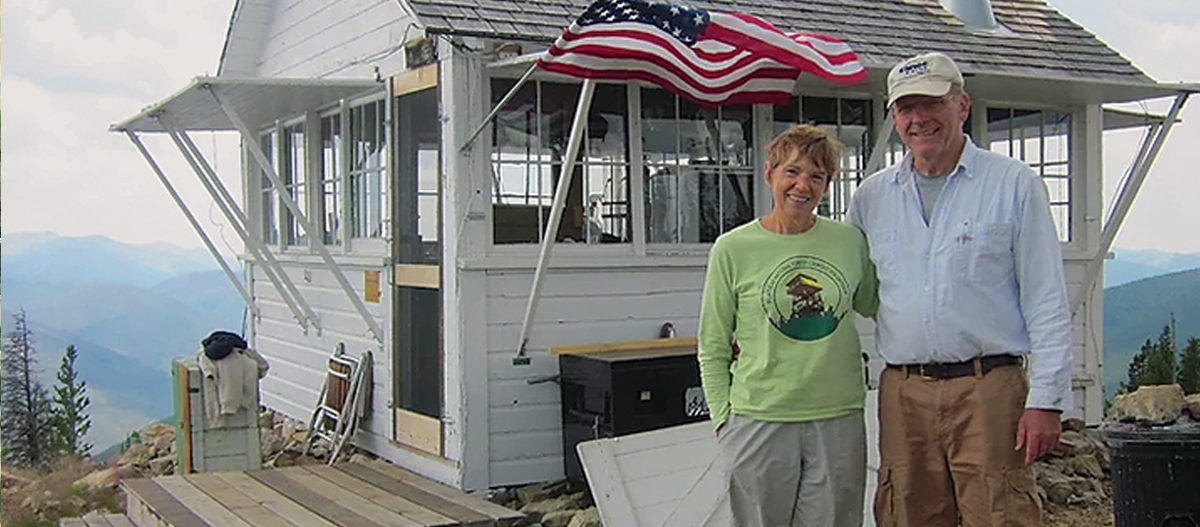by CATE HUISMAN
Not so long ago, many of us outdoor-focused young people in the Mountain West dreamt of becoming forest fire lookouts. We anticipated long summer days, staring out over a vast oceans of trees, looking for the gray-blue wisps of smoke that would foretell fires.
We read Gary Snyder and Jack Kerouac and envisioned writing our own sylvan visions during long, contemplative hours alone on the heights.
Chuck Manning of Kalispel lived that dream in the summer of 1963, which he spent gazing across the North Fork of the Flathead from Thoma Lookout, just south of the Canadian border. But instead of going on to publish poetry, he went to college and got a job like the rest of us. During summers in college, he found he could earn more as a construction worker than as a lookout.
Half-a-century later, perhaps fewer young people are dreaming of being lookouts, as few such positions remain. Many tasks once performed by human lookouts have been taken over by modern surveillance technologies, and many of the remote mountaintop cabins where lookouts did or did not become philosophers have fallen into disrepair.
Manning is now retired after teaching art and aviation at Kalispel High School for 28 years. But in 2012, he heard of a program that was looking for volunteers to staff some lookouts on the Flathead National Forest near his home in northwest Montana. He and his wife Nancy spent a week at Firefighter Lookout, overlooking Hungry Horse Reservoir south of West Glacier.
At the end of that summer, they joined a social gathering of other such volunteers. The group got to talking about the deferred maintenance needs they had noticed in their lofty perches. Manning threw out the idea of starting an organization to help with maintenance of these historic structures. It was well received, so he started contacting people in the U.S. Forest Service to discuss options.
Little did Manning know that such an organization already existed: the aptly named Forest Fire Lookouts Association (FFLA), a national group founded back East more than a quarter-century ago, to preserve historic lookouts. Manning found their mission mirrored the one he and his comrades had in mind, with the added advantage that becoming a chapter of FFLA could save them all the fuss of starting their own nonprofit organization. And even with this national affiliation, all the money they could raise in Montana would stay in Montana.
Northwest Montana has a lot of advantages for an organization such as this. It has a lot of mountains and a lot of lookouts, and it’s a fair guess that it’s also home to a lot of the kinds of people who dreamed of staffing them. Since even back in the 1960s, there weren’t that many lookout jobs, and they didn’t pay enough to support a family (much less provide a lifestyle that was conducive to raising one), another fair guess is that those dreamers have been doing something else in the last half-century, but they haven’t forgotten that dream.
It’s no surprise that the NWMT chapter is one of the most active in the country. Each summer for the past four years, members have generated somewhere between 900 and 1000 hours’ worth of donated work and in-kind value to preserve local lookouts.
This has saved the agencies the chapter works with—the U.S. Forest Service, National Park Service (for lookouts in Glacier National Park), and Montana Department of Natural Resources—some $30,000 to $40,000 each year.
One of the first projects was inventorying the stock of remaining lookouts, and a raft of volunteers visited them to document the condition of each. Then the chapter worked with the agencies to prioritize projects.
Manning has himself participated in a lot of these projects, and those carpentry skills from college are coming in quite useful.
“Many of our volunteers have skills from working on their own projects,” he said, “and it’s invaluable to have people with those skill sets. But we can always use volunteers without those skills.”
That’s because rehabbing a lookout requires an immense amount of elbow grease.
“Probably one of the harshest environments you can imagine is on top of a mountain,” Manning pointed out. Lookouts need to be scraped and painted every three to five years, and most have gone much longer than that. Volunteers do this 10 hours a day with few distractions.
“There isn’t a lot to do, recreation-wise, once you’re up there,” Manning said.
Typically a crew of four or five will work on a single lookout for a week at a time.
“In an environment like a tower, you can only work about four people safely,” said Manning. If the lookout has a road to it, they will camp or bunk nearby and drive to the site each day.
But some lookouts are much more remote. The crew that worked on the Mud Lake Lookout in the Bob Marshall Wilderness hiked the 23 miles to the lookout over two days. A pack string hauled in their camping gear, food, tools, and supplies.
That crew used “handsaws, files, rasps—the same tools that were used when it was constructed,” said Manning. Being in the Bob, they could use only hand tools. But for other remote projects outside designated wilderness areas, pack animals have hauled in small generators and power tools as well. A couple of times, materials have been flown in by helicopter.
A complicating factor is that the lookouts are historical structures and must be rehabbed in historically correct ways with historically correct materials. The agencies work with the state historical preservation office in Helena to identify what is appropriate.
According to Manning, the materials must match the originals. “Fir with fir. Tongue-and-groove with tongue-and-groove.”
Manning noted the majority of his volunteers are of an age to read Montana Senior News.
“All the tried and true people that we work with are over 50,” he said, adding that many of the volunteers have worked with the Forest Service at some point in their lives, and they want to reconnect.
“Some have been on lookouts; some just think it’s a great experience to be on top of a mountaintop.”
They like seeing the sunrises and sunsets and the feeling of being on top of the world, he said “If you’re fortunate enough to have a thunderstorm come through, that’s just the icing on the cake.”
Want to volunteer? Check out the work of NWMT-FFLA at nwmt-ffla.org. Use the dropdown menu under “Projects” to find the latest volunteer opportunities. — MSN
Cate Huisman writes for several local publications from her home in Sandpoint, Idaho. She and her husband did the initial surveys of Ziegler Mountain and Garver Mountain lookouts.










